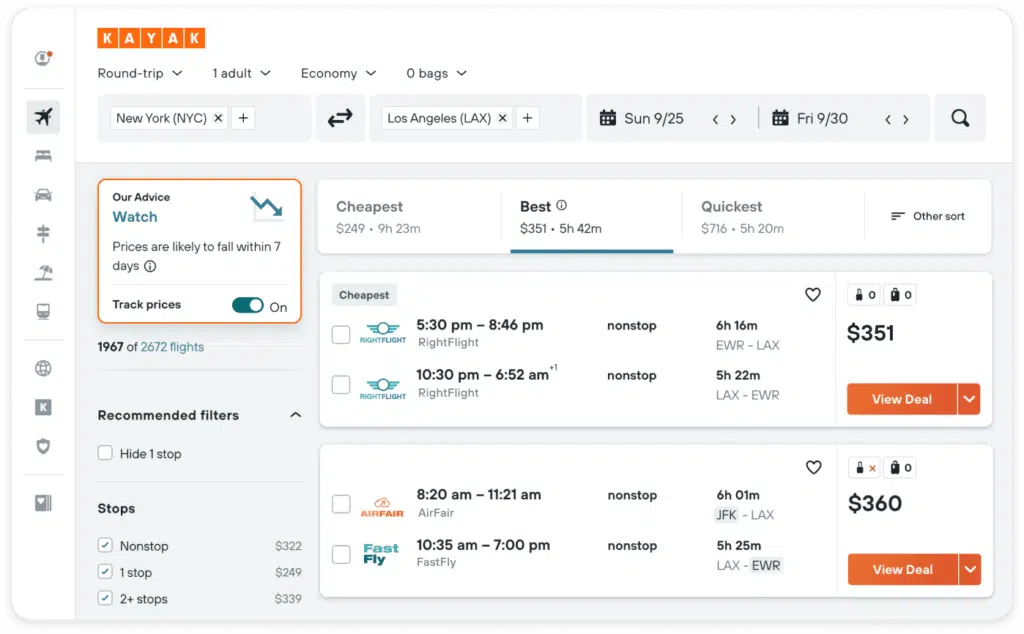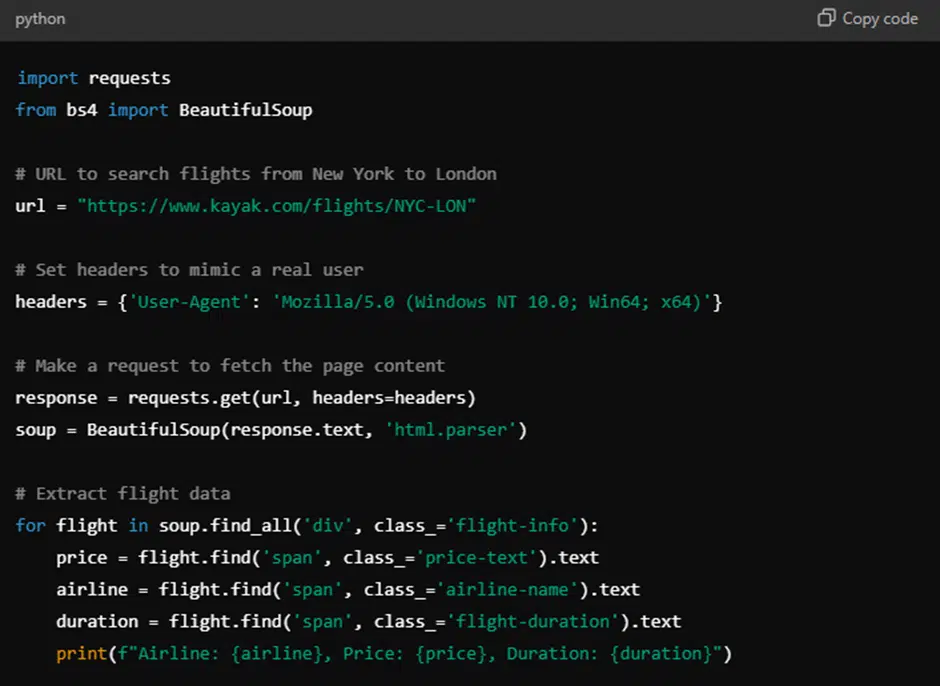
Flight data is invaluable for many sectors, from travel agencies and price comparison platforms to market researchers who need insights on trends, pricing fluctuations, and demand cycles. Kayak is a popular online travel aggregator, and its comprehensive flight listings make it an ideal source for acquiring data on flights.
This guide will walk you through the technical process of scraping flight data from Kayak, explaining the various tools and techniques involved, while ensuring that you stay compliant with web scraping guidelines and ethical considerations.
Why Scrape Flight Data?
Flight data is essential for multiple applications, such as:
- Travel Planning – Accurate, real-time flight data enables platforms to offer up-to-date travel information, helping users book at the best possible time.
- Price Monitoring – By tracking prices over time, businesses can identify trends and predict optimal purchase windows for travelers.
- Market Analysis – Historical flight data can reveal trends in consumer demand, peak travel times, and pricing behavior, helping travel analysts and market researchers.
Understanding the Legal and Ethical Implications of Scraping
Before delving into the technical aspects, it’s essential to understand the legal and ethical implications of scraping Kayak’s data:
- Terms of Service Compliance – Check Kayak’s Terms of Service to ensure that scraping is allowed. Some websites prohibit automated access, so understanding the legal boundaries can help you avoid potential issues.
- Respect Robots.txt – Review Kayak’s robots.txt file to identify pages that allow or restrict bot access.
- Avoiding Server Overload – Conduct scraping responsibly by limiting request frequency to avoid overloading Kayak’s servers.
By maintaining ethical scraping practices, you can gather the data you need while respecting Kayak’s platform.
What is Kayak?

Image Source: Kayak
Kayak is a popular travel search engine that helps users find the best deals on flights, hotels, car rentals, and vacation packages. Launched in 2004, Kayak aggregates and compares prices from various travel sites, allowing users to book directly through providers or on Kayak’s own platform.
Known for its user-friendly interface and features like price tracking and flexible date search, Kayak simplifies the travel planning process by delivering comprehensive, up-to-date travel options tailored to individual preferences and budgets.
How to Scrape Flight Data from Kayak?
Scraping flight data from a platform like Kayak involves understanding its web structure and identifying key data points for extraction. Here’s a step-by-step guide to get you started.
1. Define the Scope of Your Flight Data Requirements
Before you begin, identify what data you need. Some common flight data elements include:
- Flight Routes – Departure and destination cities.
- Pricing Information – Price ranges, deals, and discounts.
- Flight Times – Departure and arrival times, flight duration.
- Airlines – Carrier details for flights.
Knowing what data you need helps structure your scraper efficiently and avoid unnecessary processing.
2. Set Up Your Development Environment
To get started with scraping, you’ll need a few key tools and libraries:
- Python – Python’s simplicity and its libraries make it ideal for web scraping.
- Libraries:
- Requests – For making HTTP requests.
- BeautifulSoup – For parsing HTML.
- Selenium – For navigating dynamically loaded content, as Kayak often uses JavaScript for data loading.
- Pandas – For organizing and storing data.
- Scrapy – A more robust framework for larger-scale scraping.
Install these packages via pip:

3. Inspect Kayak’s Website Structure
Open Kayak in your browser and use the developer tools (typically accessible with F12) to examine the site structure. Pay close attention to the flight search results page since it’s the primary source for your data. Identify specific HTML elements and classes that contain the data you wish to scrape.
You may find that the data is loaded dynamically using JavaScript, which makes scraping a bit more challenging, but Selenium can help bypass this obstacle.
4. Scraping Static Data
For web pages where data is readily available in the HTML source, you can use Requests and BeautifulSoup for scraping. Here’s a sample code snippet:

This basic code example should be able to pull static flight data such as airline name, price, and flight duration if the data is available in the HTML source.
5. Handling Dynamic Content with Selenium
If data on Kayak is loaded via JavaScript (which is often the case), you’ll need to use Selenium, which can mimic a user interacting with the page. Here’s a simplified example:

Using Selenium allows you to bypass JavaScript-loaded content, making it ideal for scraping real-time flight data from Kayak.
6. Organizing Data with Pandas
Once you’ve extracted the data, store it in a structured format using Pandas for easy analysis and storage. Here’s how:

Storing data in a structured format like CSV allows for efficient analysis of historical flight data and facilitates integration with other data tools.
Advanced Techniques to Maximize Flight Data Scraping Efficiency
1. Rotate Proxies
Since Kayak may block repeated requests from the same IP address, consider rotating proxies to avoid detection. Services like ProxyMesh or ScraperAPI can be helpful.
2. Implement Random Delays
To mimic human behavior, add random delays between requests to reduce the risk of being flagged as a bot. The time.sleep() function can help achieve this.
3. Use Headless Browsing
Running Selenium in headless mode can speed up scraping by reducing browser load time. Set options.headless = True for faster performance.
Why Choose PromptCloud’s Flight Data Solutions for Travel Insights?
While building a scraper can yield custom results, professional flight data solutions providers like PromptCloud offer real-time flight data and historical flight data with minimal setup. These services provide scalable data solutions with continuous support and data quality assurance, which can save time for developers and analysts looking to focus on insights rather than infrastructure.
Conclusion
Scraping flight data from Kayak can unlock valuable insights into the travel industry, helping travel analysts and developers make better decisions based on real-time flight data and historical flight data. By following the technical steps outlined here, you can safely and efficiently gather data for analysis. Remember, respecting Kayak’s terms and being mindful of ethical considerations can keep your scraping efforts sustainable and compliant.
For businesses needing reliable data without the technical setup, flight data solutions like those from PromptCloud can offer a powerful alternative, delivering structured and ready-to-use data. Schedule a demo today!




















